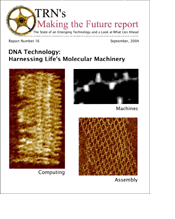
|
|
||||||
|
September 2004 DNA Technology: Harnessing Life's Molecular Machinery 39 pages  This
report examines the current state of DNA technology, organizes key
issues and puts them in context, and succinctly explains how the
technology works. This
report examines the current state of DNA technology, organizes key
issues and puts them in context, and succinctly explains how the
technology works. Researchers recognized more than a decade ago that DNA's flexible format -- four bases that can be sequenced to form many different combinations -- makes it an extremely versatile molecule that could be bent to various technical ends. In recent years scientists have advanced the prospects of tapping DNA to carry out DNA computing and mechanical assembly. Taking short stretches of artificially-constructed DNA through various connections and disconnections makes it possible to carry out computations, including the boolean logic of silicon computers. Researchers are also tapping this connection ability to coax DNA to assemble into three-dimensional structures. Specific stretches of DNA can also be engineered to bind to various materials, including tiny metal spheres, before self-assembling. This allows DNA to be used to assemble nanoscale machines and materials atom by atom. The report includes an executive summary, a list of 18 developments to look for as these cutting-edge technologies take shape, and a section of 20 researchers to watch, including links to their Web pages. It also includes a quick tour of 38 recent developments and a section of 32 in-depth news stories from TRN. The main report is organized into the following sections: biology becomes technology, sticky ends and dna tiles, computer in a test tube, readout, storage, automatons, champion of self-assembly, molecular machinery, in the grasp, molecular motors, nanotubes and nanoparticles, waffles, tubes, trees and pyramids, nanowire maker, DNA in bulk, the biochemical future. The in-depth news stories are organized into the following categories: computing, machines, assembly, structures, electronics and materials.
Take a look at all available Making the Future reports. View a four-page sample of the Making the Future report (pdf). |
||||||
|
||||||
|
© Copyright Technology Research News, LLC 2000-2005. All rights reserved. |
||||||
